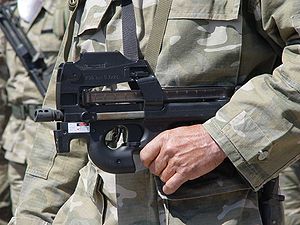Personal defense weapon

A personal defense weapon (often abbreviated PDW) is a compact firearm with increased range and better armor penetrating capabilities than a pistol, machine pistol, or submachine gun, while being smaller than a full-sized assault rifle or carbine. PDWs otherwise share many of the characteristics of submachine guns and are often classified as such, though they utilize armor-piercing ammunition which makes them more effective, forming a sort of assault rifle/carbine/submachine gun hybrid.
Origins

The Luger P08 long barrel semi-automatic pistol was the first true personal defense weapon and was issued in WWI to German artillery crews. It was manufactured with a longer barrel as it was recognized that artillery crew needed a lighter weapon than a rifle but with similar accuracy to defend themselves if needed to. It had a newly developed pistol cartridge, the 9mm Parabellum, which was designed for low recoil without sacrificing penetration and stopping power. Although not armour piercing, the bullet sufficed for the time.
The Mauser C96 was a similar endeavor but mostly used by officers; later in WWII a fully automatic version was supplied, usually with a buttstock to help to control its high rate of fire.
The M1 Carbine used in the Second World War can be considered a forerunner of modern personal defense weapons. It filled a similar role; it was primarily intended not for front line troops, but for others such as drivers, engineers and medics to defend themselves in an emergency.
In 1986, United States Army Infantry School based at Fort Benning issued the reference document Smalls Arms Strategy 2000, which defines the APDW (Advanced Personal Defense Weapon).
PDWs were developed during the late 1980s for non-combatant troops as compact automatic weapons that could defeat enemy body armor. Standard pistols and submachine guns chambered for pistol rounds had proven ineffective against armored soldiers and compact lightweight weapons capable of penetrating body armor were needed. In this role, they were supposed to be a more convenient alternative to the standard assault rifle, as their smaller size and lighter weight would be less of an encumbrance to a person whose primary function on the battlefield was not frontline fighting.
Ammunition
Typical PDWs use small-caliber, high-velocity pistol bullets capable of penetrating soft body armor up to Level IIIa. However, the wound characteristics of such ultra-light, high-velocity bullets are the object of some debate as their stopping power against unarmored opponents is considered inadequate.
The 4.6 x 30 mm and 5.7 x 28 mm cartridges have been criticized for their low terminal effectiveness. This claim comes especially from those who discount the "energy dump" theory of wound ballistics such as Dr. Martin Fackler and Dr. Gary Roberts.[citation needed] Kinetic energy manifests itself in human tissue in temporary stretching of tissue, which most tissue except for liver and neural tissue is able to withstand with little ill effect. Dr. Fackler and Dr. Roberts point out that the combination of permanent wound cavity and frequently insufficient penetration (the FBI recommends a minimum of 12 inches of penetration in ballistic gelatin) make these PDW cartridges terrible terminal performers. [citation needed]
PDWs are otherwise similar to submachine guns in most respects, and are often classified as such. Both types of guns tend to have a very high rate of fire which, when combined with the lower recoil of the smaller pistol-sized cartridges, increases the probability of multiple hits.
Applications
The PDW concept has not been widely successful, among other reasons because PDWs are not significantly cheaper to manufacture than full sized assault rifles. The potential military market for PDWs have been dampened, due to the introduction of shortened versions of assault rifles called carbines, that otherwise retain most features and compatibility of their full-sized relatives.
Additionally, PDWs usually require a special cartridge, such as the 5.7 x 28 mm Cartridge for the FN P90, which are not compatible with existing pistol or rifle rounds.
Though they have never become very popular for military applications, many personal defense weapons have found their way into the hands of security forces and some special forces as direct replacements for submachine guns. Like submachine guns, PDWs are ultra-light weapons, and their high rate of fire and lower recoil from pistol-sized cartridges enable higher accuracy. Assault rifles and carbines, by comparison, are generally heavier and have higher muzzle blast and recoil and may overpenetrate due to their rifle rounds.
Modern PDWs
- Fabrique Nationale P90
- Heckler & Koch MP7
- Knight's Armament Company PDW
- Magpul PDR
- PDW 17 Libra
- Saab Bofors Dynamics CBJ-MS
- Type 05 PDW
- Tkachev AO-46
- VBR PDW 7.92mm [1]
- Parker Hale PDW
- Hezi SM-1
- Colt MARS
- MP5K-PDW
